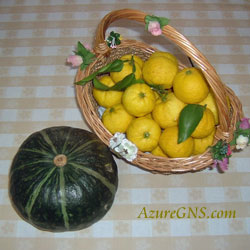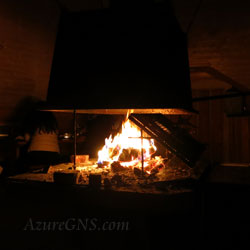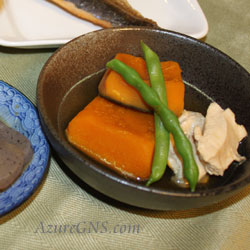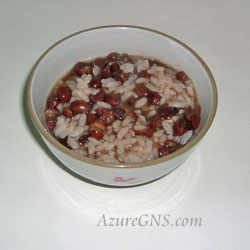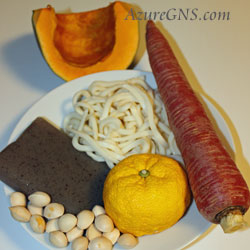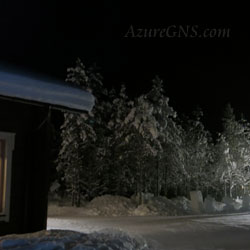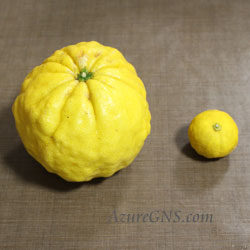(12月22日またはその前後)
Toji;
The Winter Solstice
(on or around December 22nd)
●冬至 Toji, the winter solstice
●かぼちゃ pumpkin; squash
●れんこん lotus root; lotus rhizome
●にんじん carrot
●ぎんなん ginkgo nut
●きんかん kumquat
●うどん udon; Japanese white thick noodles made from wheat flour
●こんにゃく konnyaku; gelatinous food made from the starch of konnyaku potato
●柚子 yuzu; small citrus fruit
●柚子湯 hot bath scented with yuzu
●風邪をひく catch a cold
●無病息災 perfect health; sound health
◆春分の日から1年を24等分にしたものを二十四節季と呼び、その22番目の期間が冬至です。
Toji is the 22nd period of Niju-shi-sekki: 24 seasonal divisions of a year which starts on Risshun (the first day of spring by the lunar calendar).
◆この考えは旧暦と実際の季節のずれを埋めるために中国で生まれました。
This idea comes from China so as to bridge the gap between the lunar calendar and the actual seasons.
◆冬至に太陽は一年中で最も南に位置します。
On the day of Toji, the sun is located in the southernmost position.
◆この日、北半球では太陽の高さが一年中で最も低く、昼が最も短く、夜が最も長くなります。
On this day in the Northern Hemisphere, the height of the sun is at its lowest, the day is the shortest, and the night is the longest of the year.
◆中国では古代より冬至は暦の始まりとして重大な意味を持ち、厳粛な儀式が行われました。
In ancient China, Toji was very significant as the beginning of the calendar, and solemn ceremonies were held.
◆それが中世に日本の宮中へ伝わりました。
It was introduced to the Japanese Court in the Middle Ages.
◆冬至は普通12月22日か23日頃です。
Toji is usually on or around December 22nd or 23rd.
◆19年に一度旧暦の11月1日になり、これを朔旦冬至(さくたんとうじ)と呼び、特別大きな祝賀行事が行われます。
Once every 19 years, Toji falls on November 1st in the lunar calendar, and this Toji is called Sakutan-toji in which an especial big celebration ceremony is held.
◆冬至にかぼちゃを食べると病気にならないという古くからの言い伝えがあります。
It has been said since old times that eating pumpkin on the day of Toji prevents us from catching illness.
◆かぼちゃには多くのカロチンやビタミンが含まれるので健康に良い食べ物です。
Pumpkins are a healthy food because they contain a lot of carotene and vitamins.
◆またこの日に小豆を食べる習慣もあります。
Eating azuki beans (small reddish-brown beans) is another custom on Toji.
◆小豆粥や、小豆とかぼちゃを一緒に醤油と砂糖で煮たものがよく食べられます。
People often eat azuki-gayu (rice porridge with azuki beans) and/or boiled azuki beans and pumpkins seasoned with soy sauce and sugar.
◆そしてまた、「ん」が付く名前の食品を食べると縁起が良いとされ、その理由には諸説あります。
Foods whose names contain “ん (n)” are also regarded as foods which bring good luck, and there were some theories about its reason.
◆その一つは「ん」はいろは歌の最後の文字で、冬が終わり春の訪れを象徴しているからです。
One of the theories is that “ん (n)” is the final letter of the Japanese “I-ro-ha” alphabet and symbolizes the end of winter and the coming of spring.
◆他の節では、「ん」は「うん(運)」と音が似ているので、「ん」が付く名前の食品は運が良いとされています。
Another theory is that “ん (n)” sounds like “うん (un)” – the Japanese word for lucky, and so the names of foods containing this sound are said to be lucky.
◆代表的なものが南瓜(なんきん)、蓮根、人参、銀杏、金柑、寒天、饂飩で、これらは冬至の七種(ななくさ)と呼ばれています。
The representative ingredients, known as Toji-no-nana-kusa (the seven ingredients for the Winter Solstice), are nankin (pumpkin, also called kabocha), renkon (lotus root), ninjin (carrot), ginnan (ginkgo nut), kinkan (kumquat), kanten (agar) and udon (Japanese noodle made from flour).
◆その他、こんにゃくも好んで食べられます。
Besides them, konnyaku (gelatinous food made from the starch of konnyaku potato) is very popular.
◆こんにゃくは「砂払い」と呼ばれ、体の毒を外に出すと言われています。
Konnyaku is called “Suna-harai” (sweeping the sand away) because it is said to take poison out of the body.
◆そして柚子湯に入ると病気にならず、邪気を祓うとされます。
People take hot baths scented with yuzu to remain healthy and drive away evil spirits.
(より詳しい情報は「我が家の冬至」を覧下さい。)
(Please see “Our Winter Solstice Experience” for further information.)
Copyright (C) Azure Global Network Services. All Rights Reserved.
